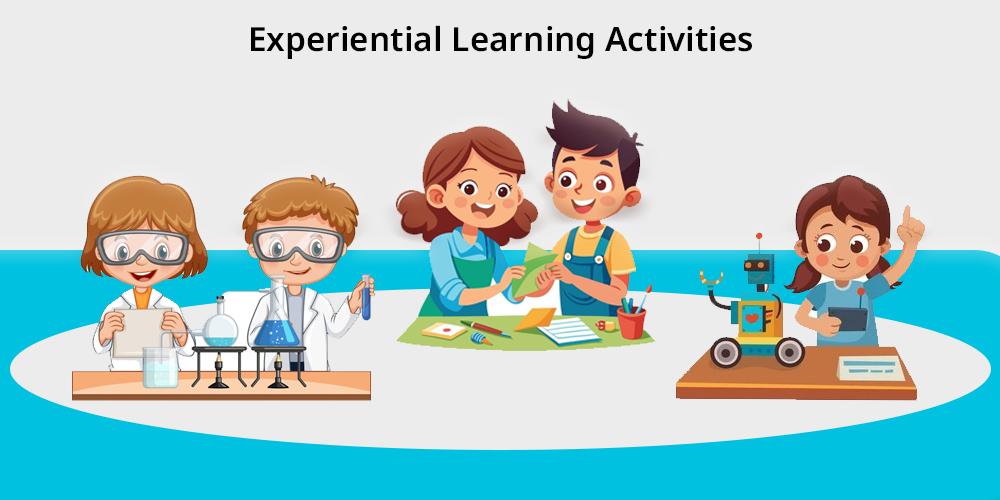
In today’s fast-changing world, traditional learning methods often fall short in preparing students for real-life challenges. Simply memorising facts isn’t enough.
What students need is active participation, hands-on practice, and opportunities to connect knowledge with real-world situations. That’s where experiential learning steps in.
Experiential learning transforms classrooms into spaces of discovery, creative thinking , and meaningful engagement.
Whether it’s through simulations, group projects, field visits, or community work, students learn by doing, reflecting, and applying. This approach builds not only academic skills but also confidence, collaboration, and problem-solving.
Contents
- What Is Experiential Learning?
- 15 Experiential Learning Activities for Students
- 1. Role-Playing & Simulations
- 2. Project-Based Learning (PBL)
- 3. Field Trips & Educational Visits
- 4. Service Learning Projects
- 5. Science Experiments & STEM Challenges
- 6. Case Study Analysis
- 7. Interactive Group Games & Simulations
- 8. Arts Integration
- 9. Reflective Observation
- 10. Volunteering
- 11. Field Excursion
- 12. Learning Tournaments
- 13. Community Action Projects
- 14. Prodigy
- 15. Virtual Reality in the Classroom
- Tips for Teachers to Implement Experiential Learning
- Challenges in Experiential Learning and How to Overcome Them
- Final Thoughts: Making Learning Meaningful and Memorable
What Is Experiential Learning?

Experiential learning is an educational approach where students learn through experience. It involves a continuous cycle of doing, thinking, analysing, and reapplying.
Instead of passively listening to a lecture, students engage with content, take action, reflect on outcomes, and use those insights to shape future learning.
American educational theorist David Kolb outlined this model in four stages:
- Concrete Experience (doing something)
- Reflective Observation (thinking about what happened)
- Abstract Conceptualisation (understanding the learning)
- Active Experimentation (trying again in a new way)
Experiential learning works across all age groups and subjects. It supports different learning styles and nurtures critical life skills like creativity, adaptability, and communication, making it one of the most effective teaching strategies in modern classrooms
15 Experiential Learning Activities for Students

Here are 15 proven experiential learning activities that engage students deeply, promote retention, and make learning enjoyable.
1. Role-Playing & Simulations

The role-playing activities help students take on roles such as a news reporter, scientist, freedom fighter, or business leader. By immersing themselves in different characters and scenarios, they explore complex ideas and learn to view situations from multiple perspectives.
2. Project-Based Learning (PBL)

In PBL , students tackle real-world problems over weeks or months. Whether designing eco-friendly homes or organising school events, they collaborate, research, and present outcomes, gaining academic knowledge and 21st century skills .
3. Field Trips & Educational Visits

Field visits to museums, factories, farms, or heritage sites connect theory with real life. These outings encourage observation, curiosity, and application of classroom lessons in new environments.
4. Service Learning Projects
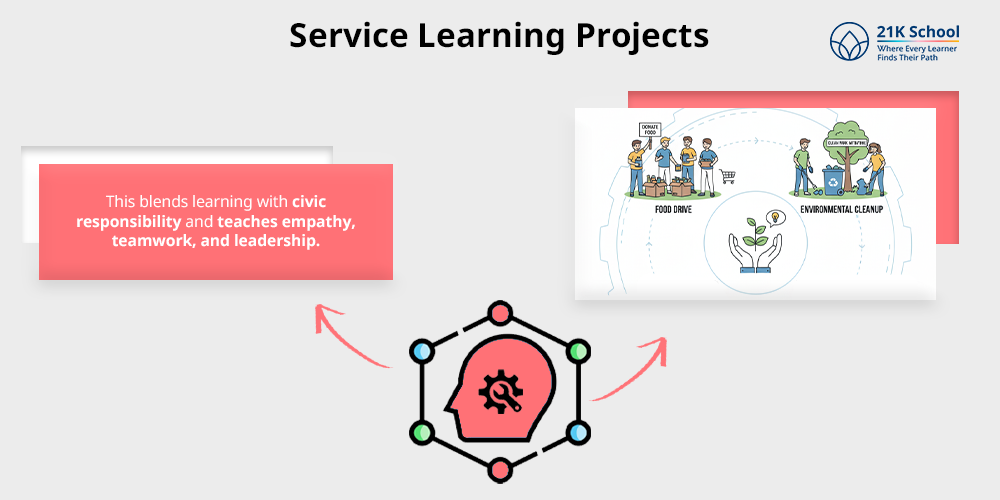
Students identify community needs, such as food drives or environmental campaigns, and work towards solutions in their service learning projects. This blends learning with civic responsibility and teaches empathy , teamwork, and leadership.
You should also read: Leadership Activities for Students
5. Science Experiments & STEM Challenges

Students engage in hands-on activities like building simple machines, growing plants, or testing physics laws in science experiments . These challenges sharpen inquiry skills, encourage discovery, and boost interest in science and technology.
6. Case Study Analysis

Learners analyse detailed case studies that mirror real-life dilemmas in fields like health, business, or history. This builds analytical thinking, decision-making skills and the ability to consider various viewpoints.
7. Interactive Group Games & Simulations

Games like debates, model UN, and classroom escape rooms engage students while reinforcing subject matter. These activities teach collaboration , logic, and adaptability in high-energy, focused ways.
8. Arts Integration

In arts integration, students use drama, drawing, music, or dance to explore academic topics. This helps learners express understanding in creative ways, deepens comprehension, and makes abstract concepts easier to grasp.
9. Reflective Observation

Reflection helps students internalise what they’ve learned. Journals, group debriefs, or digital storytelling allow them to connect their experiences with larger ideas and improve future performance.
10. Volunteering

Volunteering in the local community builds real-world skills, from teamwork to time management . Students also develop compassion and see how their learning can positively impact the world around them.
11. Field Excursion

Unlike regular trips, field excursions are planned around specific academic goals. A geography class might survey soil types, while a science class observes species in a local ecosystem, making learning purposeful and data-driven.
12. Learning Tournaments

Tournaments combine learning with healthy competition. Spelling bees, math olympiads, or coding contests build focus, encourage revision, and make academic achievement exciting and social.
13. Community Action Projects

Students work in groups to identify a local challenge and create a solution, like water conservation, traffic safety, or school cleanliness. These projects teach responsibility, problem-solving , and long-term planning.
14. Prodigy

Platforms like Prodigy turn subjects like math into immersive games. Students move through quests by solving academic challenges, making learning interactive, personalised, and fun.
15. Virtual Reality in the Classroom

Using VR, students explore historical landmarks, human anatomy, or outer space. These immersive experiences make abstract content come alive and support visual and kinesthetic learning styles.
Tips for Teachers to Implement Experiential Learning
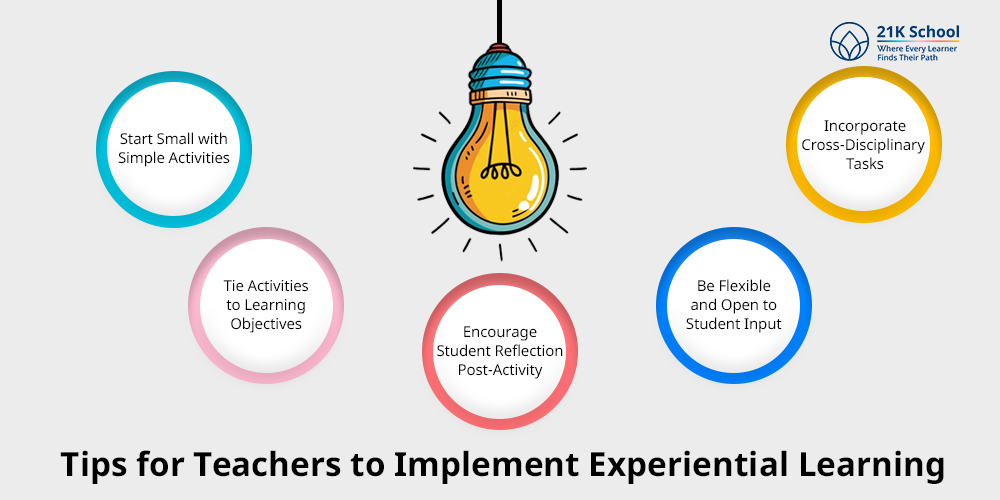
Incorporating experiential learning into your teaching doesn’t have to be overwhelming. Here’s how you can start small and build from there:
1. Start Small with Simple Activities
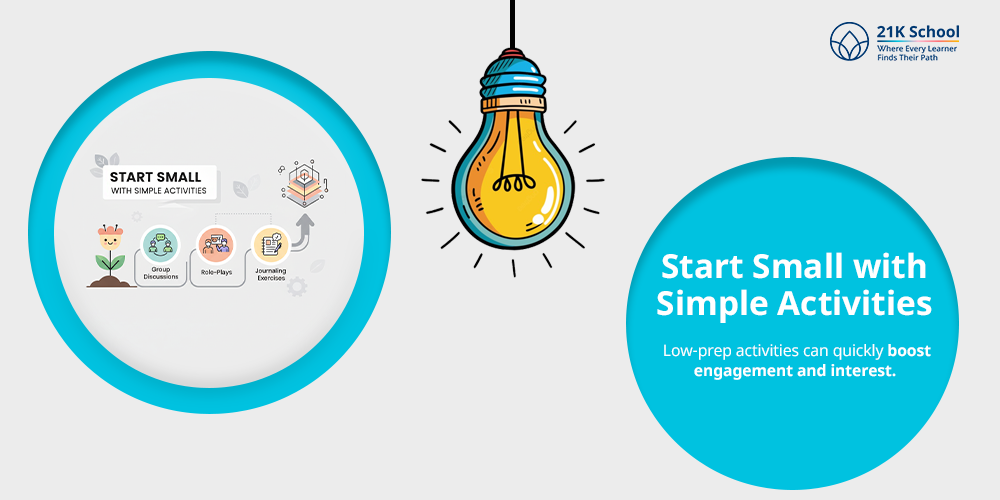
Begin with short, focused tasks like group discussions, role-plays, or short journaling exercises. These low-prep activities can quickly boost engagement and interest.
2. Tie Activities to Learning Objectives

Link each activity to a clear academic goal. For example, a recycling project in science reinforces environmental studies. Clear connections help students understand the value of what they’re doing.
3. Encourage Student Reflection Post-Activity

Use exit slips, group reflections, or individual journals to help students process what they’ve experienced. This helps turn action into long-term understanding and personal growth.
4. Be Flexible and Open to Student Input

Give students voice and choice in how they learn. Allowing them to propose ideas or pick their project topics increases ownership and motivation.
5. Incorporate Cross-Disciplinary Tasks

Blend subjects for a richer experience. A project on building a sustainable city can include elements of geography, economics, math, and art, encouraging holistic education
Challenges in Experiential Learning and How to Overcome Them
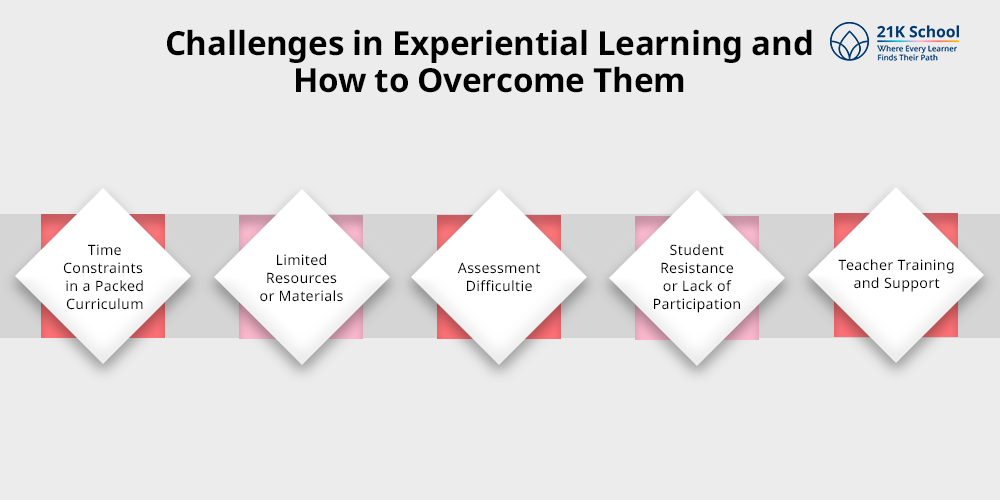
While experiential learning has many benefits educators may face a few practical challenges. Here’s how to address them:
1. Time Constraints in a Packed Curriculum

Teachers often feel pressure to cover vast syllabi. Try integrating quick experiential elements, like 10-minute group tasks or discussions, without sacrificing content.
2. Limited Resources or Materials

Lack of equipment shouldn’t stop you. Use everyday items, recycled materials, or free digital tools. Often, creativity is more powerful than expensive tools.
3. Assessment Difficulties

Experiential learning outcomes are not always easy to grade. Use rubrics that evaluate both the process and the product. Focus on skills like collaboration, critical thinking , and creativity.
4. Student Resistance or Lack of Participation

Some students may be hesitant. Start with low-pressure activities in pairs or small groups. Celebrate effort, not just results, and offer support to build confidence over time.
5. Teacher Training and Support

Many teachers feel unsure about implementing new methods. Schools can support by offering workshops, mentoring, or online resources that build skills and confidence.
Final Thoughts: Making Learning Meaningful and Memorable
Incorporating experiential learning activities is not just a trend; it’s a meaningful shift toward preparing students for life
This method helps them develop a growth mindset, become active participants in their learning, and apply what they learn far beyond the classroom.
Here are 10 basic life skills not taught in schools
Whether it’s a group project, community service, or a VR field trip, these experiences stay with students longer than lectures ever will.
For educators and parents alike, investing in experiential learning means building curious , capable, and compassionate individuals ready to thrive in the real world. Start small, stay consistent, and watch how learning becomes an experience worth remembering.


